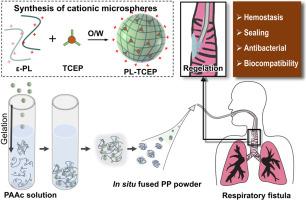An in situ fused adhesive with integrated antibacterial and hemostatic functionalities for urgent respiratory fistula sealing and enhanced wound repair
IF 9.6
1区 医学
Q1 ENGINEERING, BIOMEDICAL
引用次数: 0
Abstract
Respiratory fistulas remain clinically challenging in endoscopic treatment due to the absence of convenient non-compressive sealing materials. Here, we developed an in situ self-fused powder adhesive (PP powder) to address this limitation. This material integrates the adaptive conformability of hydrogel microparticles with the pressure-resistant sealing capability of bulk hydrogels via water-triggered self-assembly. The PP powder exploits electrostatic attraction and topological effects between cationic microspheres (PL-TCEP) and polyacrylic acid (PAAc). This design yields strong tissue adhesion (29.7 kPa), robust sealing (24.7 kPa), and inherent antibacterial properties. Additionally, it promotes efficient coagulation by synergistically aggregating blood cells and autoactivating the coagulation cascade. Furthermore, we have rigorously validated those hemostatic, sealing, healing capabilities and translational potential through liver injury models, bronchopleural fistula models, infected wound models and rabbit tracheal fistula models. This multifunctional platform advances emergency fistula management while providing a paradigm for designing biomaterials addressing complex clinical scenarios requiring simultaneous hemostasis, sealing, and antimicrobial action.
Statement of Significance
This study introduces a rapidly self-assembled poly(amino acid)-based microgel, formed through dynamic ionic crosslinking between cationic poly(amino acids) and poly(acrylic acid) (PAAc). This microgel exhibits exceptional deliverability through narrow channels and hygroscopic self-assembly capabilities, making it an ideal candidate for endoscopic surgical applications, particularly in sealing respiratory tract fistulas. The engineered microgel demonstrates robust mechanical properties, far exceeding the physiological pressures of human airways. Leveraging the spatial architecture of cationic poly(amino acid) microspheres, the microgel not only exhibits inherent antimicrobial activity but also significantly enhances blood cell aggregation, thereby accelerating clot formation more effectively than commercial hemostatic powders. Furthermore, owing to its outstanding biocompatibility, the microgel shows great promise in visceral hemostasis and tissue regeneration, highlighting its potential for advanced biomedical applications.

一种具有抗菌和止血功能的原位融合胶粘剂,用于紧急呼吸瘘管密封和伤口修复。
由于缺乏方便的非压缩密封材料,呼吸瘘管在内镜治疗中仍然具有临床挑战性。在这里,我们开发了一种原位自熔粉末粘合剂(PP粉末)来解决这一限制。这种材料通过水触发的自组装将水凝胶微粒的自适应一致性与大块水凝胶的耐压密封能力结合在一起。PP粉体利用阳离子微球(PL-TCEP)与聚丙烯酸(PAAc)之间的静电吸引和拓扑效应。这种设计具有很强的组织粘附力(29.7 kPa),坚固的密封性(24.7 kPa)和固有的抗菌性能。此外,它通过协同聚集血细胞和自动激活凝血级联促进有效凝血。此外,我们通过肝损伤模型、支气管胸膜瘘模型、感染创面模型和兔气管瘘模型严格验证了其止血、密封、愈合能力和转化潜力。这个多功能平台推进了紧急瘘管管理,同时为设计生物材料提供了范例,以解决需要同时止血、密封和抗菌作用的复杂临床情况。意义声明:本研究介绍了一种快速自组装的聚氨基酸基微凝胶,它是通过阳离子聚氨基酸和聚丙烯酸(PAAc)之间的动态离子交联形成的。这种微凝胶具有通过狭窄通道和吸湿自组装能力的特殊输送能力,使其成为内窥镜手术应用的理想候选者,特别是在封闭呼吸道瘘管方面。该工程微凝胶显示出强大的机械性能,远远超过人类气道的生理压力。利用阳离子聚氨基酸微球的空间结构,微凝胶不仅具有固有的抗菌活性,而且显著增强血细胞聚集,从而比商业止血粉末更有效地加速凝块形成。此外,由于其出色的生物相容性,微凝胶在内脏止血和组织再生方面显示出巨大的前景,突出了其在先进生物医学应用方面的潜力。
本文章由计算机程序翻译,如有差异,请以英文原文为准。
求助全文
约1分钟内获得全文
求助全文
来源期刊

Acta Biomaterialia
工程技术-材料科学:生物材料
CiteScore
16.80
自引率
3.10%
发文量
776
审稿时长
30 days
期刊介绍:
Acta Biomaterialia is a monthly peer-reviewed scientific journal published by Elsevier. The journal was established in January 2005. The editor-in-chief is W.R. Wagner (University of Pittsburgh). The journal covers research in biomaterials science, including the interrelationship of biomaterial structure and function from macroscale to nanoscale. Topical coverage includes biomedical and biocompatible materials.
 求助内容:
求助内容: 应助结果提醒方式:
应助结果提醒方式:


